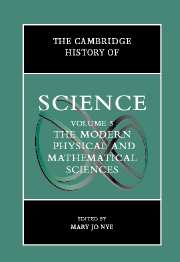Book contents
- Frontmatter
- Introduction: The Modern Physical and Mathematical Sciences
- Part I The Public Cultures of the Physical Sciences After 1800
- 1 Theories of Scientific Method
- 2 Intersections of Physical Science and Western Religion in the Nineteenth and Twentieth Centuries
- 3 A Twisted Tale: Women in the Physical Sciences in the Nineteenth and Twentieth Centuries
- 4 Scientists and Their Publics: Popularization of Science in the Nineteenth Century
- 5 Literature and the Modern Physical Sciences
- Part II Discipline Building in the Sciences: Places, Instruments, Communication
- Part III Chemistry and Physics: Problems Through the Early 1900s
- Part IV Atomic and Molecular Sciences in the Twentieth Century
- Part V Mathematics, Astronomy, and Cosmology Since the Eighteenth Century
- Part VI Problems and Promises at the End of the Twentieth Century
- Index
- References
1 - Theories of Scientific Method
from Part I - The Public Cultures of the Physical Sciences After 1800
Published online by Cambridge University Press: 28 March 2008
- Frontmatter
- Introduction: The Modern Physical and Mathematical Sciences
- Part I The Public Cultures of the Physical Sciences After 1800
- 1 Theories of Scientific Method
- 2 Intersections of Physical Science and Western Religion in the Nineteenth and Twentieth Centuries
- 3 A Twisted Tale: Women in the Physical Sciences in the Nineteenth and Twentieth Centuries
- 4 Scientists and Their Publics: Popularization of Science in the Nineteenth Century
- 5 Literature and the Modern Physical Sciences
- Part II Discipline Building in the Sciences: Places, Instruments, Communication
- Part III Chemistry and Physics: Problems Through the Early 1900s
- Part IV Atomic and Molecular Sciences in the Twentieth Century
- Part V Mathematics, Astronomy, and Cosmology Since the Eighteenth Century
- Part VI Problems and Promises at the End of the Twentieth Century
- Index
- References
Summary
Scientific methods divide into two broad categories: inductive and deductive. Inductive methods arrive at theories by generalizing from what is known to happen in particular cases; deductive methods, by derivation from first principles. Behind this primitive categorization lie deep philosophical oppositions. The first principles central to deductivist accounts are generally taken to be, as Aristotle described, “first known to nature” but not “first known to us.” Do the first principles have a more basic ontological status than the regularities achieved by inductive generalization – are they in some sense “more true” or “more real”? Or are they, in stark opposition, not truths at all, at least for a human science, because always beyond the reach of human knowledge?
Deductivists are inclined to take the first view. Some do so because they think that first principles are exact and eternal truths that represent hidden structures lying behind the veil of shifting appearances; others, because they see first principles as general claims that unify large numbers of disparate phenomena into one scheme, and they take unifying power to be a sign of fundamental truth. Empiricists, who take experience as the measure of what science should maintain about the world, are suspicious of first principles, especially when they are very abstract and far removed from immediate experience. They generally insist on induction as the gatekeeper for what can be taken for true in science.
- Type
- Chapter
- Information
- The Cambridge History of Science , pp. 19 - 35Publisher: Cambridge University PressPrint publication year: 2002
References
- 2
- Cited by



